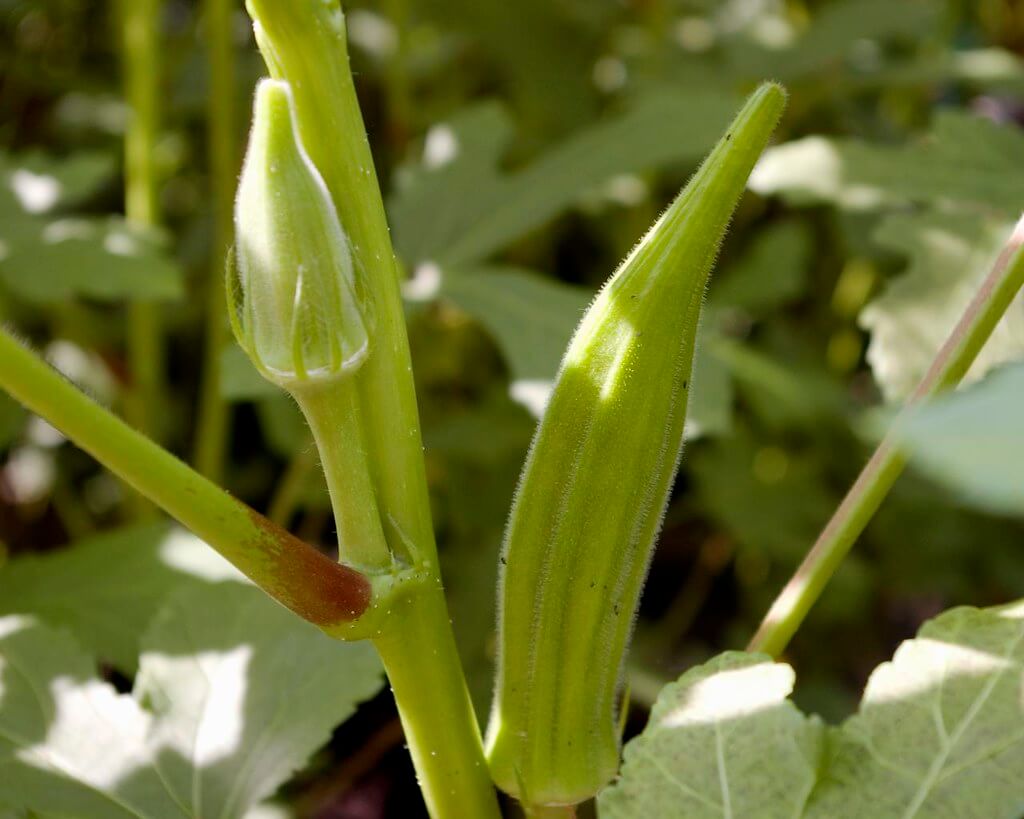
These problems are usually only an issue when growing okra in large quantities, however, and should be easy to control in smaller container gardens. Okra is often plagued by fusarium wilt and is also susceptible to attacks from nematodes, aphids, and whiteflies.

As long as you select a dwarf variety for container growing, there is also no need to worry about pinching or topping, as your plant will not grow higher than five feet tall. Okra self pollinates, so there is no need to worry about pollination. Later on in the growing process, feed the plant with lower nitrogen fertilizers instead of balanced blends, like a 5-10-15, or 6-12-12. If the soil is nitrogen rich, adding balanced fertilizer may tip the scales, promoting vegetative growth at the expense of fruiting, so do what you can to keep the balance by keeping an eye on your pH levels. Once the plant reaches six inches in height, add a dose of balanced fertilizer again. At the time of planting, you can also add a balanced fertilizer for an additional nutrient boost if you would like. To fertilize, mix manure into the soil to give nutrients to your plants and side dress the plant occasionally with it as well. Okra plants can tolerate higher temperatures very well but will fail to produce pods when the temperature gets too cool.

The plant can grow above 50 degrees F, but to flower and bear fruit with abundance, the temperature needs to be around 75 to 95 degrees. The most important factor in growing good okra is the temperature, as okra requires a lot of heat. Pay close attention to the moisture levels of the soil during the most critical period of growth, from the start of the flowering period until the end of production.
/okra--hibiscus-esculentus--star-of-david---in-fruit-135608015-5b378dd0c9e77c0037736662.jpg)
Keep the soil (or soilless medium) slightly moist at all times, watering regularly to keep the soil uniformly moist. Otherwise, you can add in a lot of organic matter, such as compost, or aged-manure to give a constant supply of essential nutrients to your okra plants. Soilless potting mixes rich in organic matter work wonderfully. The potting soil you use for okra should be loamy, crumbly, and well-draining. Like other prolific southern vegetables such as tomatoes and peppers, okra needs lots of sunlight to thrive.
#OKRA FLOWER FULL#
Once your seedlings have sprouted, pick a location that gets full sunlight for at least five to six hours per day, more if possible. The warmer the weather, the faster germination will occur. The soil needs to remain moist until your seeds germinate, which takes about five to ten days after sowing seed. Water with a watering can or a sprayer set on shower and place your containers in a bright, warm location. Sow two or three okra seeds one half to one inch deep into each pot.

Due to its taproot, okra will not transplant well, so it’s best to plant seeds into your containers directly. Growing okra year-round is possible if you live in a subtropical or tropical region, or in USDA zones 9-11. Plant when the temperature begins to stay above 55–60 degrees F and all danger of frost has passed. If you live in an area with shorter summers, pick out a variety that matures quickly. You can grow any variety of okra in a container, but dwarf varieties are better suited to container gardening than other okra plant types. When picking out your seeds, look for a dwarf okra variety that will not grow larger than five feet tall. It is best to pick out a container that is black, because it will draw in extra heat, which your okra plants will appreciate. If you use a larger pot, you can grow a few plants in it instead. For best results, a five-gallon pot that is ten to 12 inches deep with a similar diameter is the perfect size for a single okra plant. The container should be at least three gallons or larger. To begin growing okra in pots or containers, first, pick out a large pot made of whatever material you prefer. QUESTION: Can okra be grown in pots? Are they too big to plant in a container? -Paul R.ĪNSWER: Like most vegetables, okra is well suited to container gardening.


 0 kommentar(er)
0 kommentar(er)
